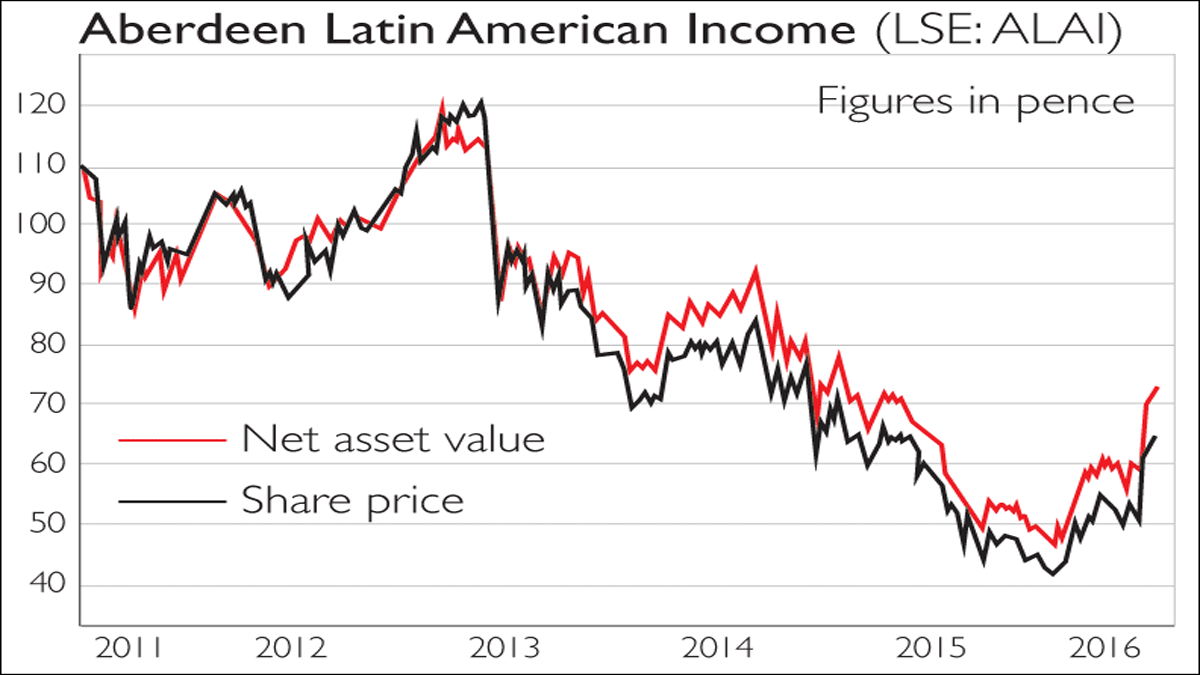The best way to play Latin America
Latin America has its problems. But that's in the price and now's the time to buy in, says David C Stevenson.


This has been a tough year for Latin America. Brazil's hosting of the Olympics in Rio was meant to showcase the country as a confident global power on the rise. Instead, its president is about to be impeached, while northern neighbour Venezuela is sliding into virtual civil war. Meanwhile, the prospect of rising US interest rates at the start of this year saw Latin American assets in general hit by collapsing commodity prices and concerns about capital flows. Investors pulled their money out of "risky" emerging-market assets and currencies to invest in developed markets instead.
However, in recent months we've seen a big rebound in Latin American asset prices, despite all the bad news. Many funds have enjoyed 30%-50% gains. The rally's strength may not last, but I increasingly think that Latin American assets are worth a look and I have a fund that might just fit the bill.
The best argument for taking a punt on Latin America now is set out by Jan Dehn and Gustavo Medeiros of emerging-market specialist fund manager Ashmore in a recent paper. The duo look at what hammered Latin American assets in the first place US dollar strength, the plunge in commodities, and populist politics. Yet those factors have changed now, they say. In fact, "Latin America is today the cheapest market in all of emerging markets. This opportunity, however, will not last forever. Investors should allocate now in order not to miss this once-in-a-decade opportunity."
MoneyWeek
Subscribe to MoneyWeek today and get your first six magazine issues absolutely FREE

Sign up to Money Morning
Don't miss the latest investment and personal finances news, market analysis, plus money-saving tips with our free twice-daily newsletter
Don't miss the latest investment and personal finances news, market analysis, plus money-saving tips with our free twice-daily newsletter
So why is Ashmore so upbeat on the future? Firstly, growth is set to pick up the International Monetary Fund "expects Latin America to have the fastest improvement in economic growth of any region in the world over the next 24 months". Secondly, both commodity prices and the US dollar have stabilised, and fears over the Fed's rate-raising plans have eased. That should support capital flows to emerging markets. Thirdly, the region is cheap Latin American bonds offer the highest yields in emerging markets, and their currencies are also the cheapest.
Better yet, at a political level, real change is evident. For all of Brazil's traumas, the impeachment is a sign that democracy is working as it should. Mexico has survived numerous narco cartel problems and continues to embrace reform slowly.
Venezuela is a socialist hellhole but my instinct is that major regime change will come within the next 12 to 18 months. Elsewhere in the region, the news is good most "of central America as well as Chile, Mexico and Uruguay [are] entirely committed to open markets, inflation targeting and sensible fiscal policies Peru, Colombia and Panama [have] launched major infrastructure investment programmes. Mexico and Colombia [have] pursued serious economic reforms, including constitutional change", say Dehn and Medeiros.
That said, I suspect that ongoing turmoil will mean a lot of volatility in Latin American equities. So I'd be more interested in playing the domestic bond markets, where slow improvements in the economic and political fundamentals will have a direct impact. One of the best ways to play this is via the Aberdeen Latin American Income (LSE: ALAI) investment trust.
This listed fund invests in both equities and bonds, and currently has a 60/40 bias towards local (mainly sovereign) bonds. This allows the fund to pay a nice dividend yield of 6%, although do be aware that the value of the fund overall will probably be very volatile.
The country bias also looks good to me nearly half of the fund's assets are in Brazil, followed by Mexico and then Uruguay. The fund still trades on a chunky 15% discount to net asset value. If everything goes the right way for Latin America over the next year and the global economy avoids recession I reckon we could see as much as 20%-30% upside over the next year, as well as that generous dividend yield.
Get the latest financial news, insights and expert analysis from our award-winning MoneyWeek team, to help you understand what really matters when it comes to your finances.

David Stevenson has been writing the Financial Times Adventurous Investor column for nearly 15 years and is also a regular columnist for Citywire.
He writes his own widely read Adventurous Investor SubStack newsletter at davidstevenson.substack.com
David has also had a successful career as a media entrepreneur setting up the big European fintech news and event outfit www.altfi.com as well as www.etfstream.com in the asset management space.
Before that, he was a founding partner in the Rocket Science Group, a successful corporate comms business.
David has also written a number of books on investing, funds, ETFs, and stock picking and is currently a non-executive director on a number of stockmarket-listed funds including Gresham House Energy Storage and the Aurora Investment Trust.
In what remains of his spare time he is a presiding justice on the Southampton magistrates bench.
-
 Goodwin: A superlative British manufacturer to buy now
Goodwin: A superlative British manufacturer to buy nowVeteran engineering group Goodwin has created a new profit engine. But following its tremendous run, can investors still afford the shares?
-
 Is US stock market exceptionalism over?
Is US stock market exceptionalism over?US stocks trailed the rest of the world in 2025. Is this a sign that a long-overdue shift is underway?